When Paul Rosenblatt answers the phone, he says “Bananas!”
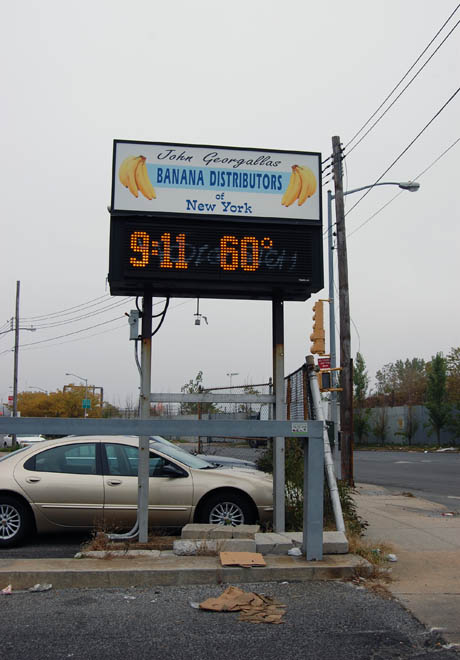
IMAGE: All photos from our visit to the Banana Distributors of New York were taken by me, unless otherwise noted.
Rosenblatt ships a million boxes of bananas every year from the Banana Distributors of New York facility on Drake Street, in the Hunt’s Point section of the Bronx. When I visited, a couple of weeks ago, he had 20,000 cases of bananas, each weighing 40lbs, in the building.
I was there with a group of students from my “Artificial Cryosphere” class — a research seminar on the built landscape of refrigeration that I’m teaching at Columbia University’s Graduate School of Architecture, Planning, and Preservation this autumn. Contrary to popular belief, as well as to Chiquita’s famous advertising jingle, bananas are the ultimate refrigerated fruit. A behind-the-scenes tour at the Banana Distributors of New York contains several examples of the banana supply chain’s evolving architecture of atmospheric control.
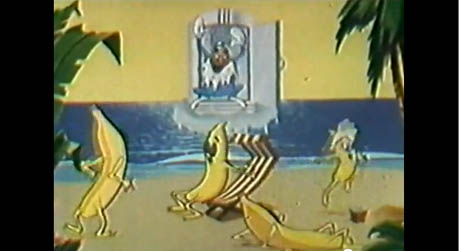
IMAGE: The Chiquita banana advertisement premiered in 1944, with the lyrics: “I’m a Chiquita banana and I’ve come to say / Bananas have to ripen in a certain way / […] Bananas like the climate of the very, very tropical equator / So you should never put bananas in the refrigerator.”
In 1899, Scientific American published careful instructions as to how to peel that most exotic and rare of fruits, the banana. But by 1914, bananas were so common that a popular scouting manual suggested that a daily good turn might well consist of “moving a piece of banana peel from the pavement.” Meanwhile, in 1903, United Fruit introduced its first refrigerated banana boat. As Sarah Murray explains in Movable Feasts:
Without refrigerated transport, shiploads of fruit frequently arrived at best overripened, at worst in a downright rotten state, making the mass marketing of bananas impossible. With the preservative power of refrigeration and the speed of steam-powered engines, however, bananas could be shipped in enormous volumes. […] In a matter of decades, refrigerated vessels had helped turn what in the 1890s was an exotic curiosity into a mass-market product, paving the way for a massive and highly lucrative trans-American trade.
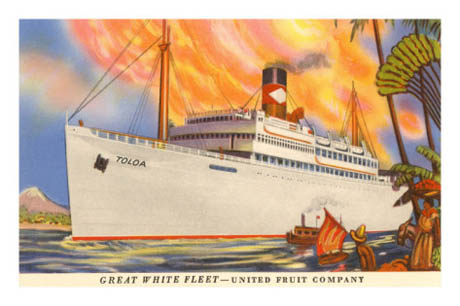
IMAGE: By 1928, United Fruit had its own fleet of eight refrigerated steamships, painted white so as to reflect the sun and assist with cooling. In Movable Feasts, Murray also provides a concise overview of the devastating impact that American fruit companies had on Central American political and economic development.
In other words, in order to be a global commodity rather than a tropical treat, the banana has to be harvested and transported while completely unripe. Bananas are cut while green, hard, and immature, washed in cool water (both to begin removing field heat and to stop them from leaking their natural latex), and then held at 56 degrees — originally in a refrigerated steamship; today, in a refrigerated container — until they reach their country of consumption weeks later.
What this means is that ripening must then be artificially induced, in a specialized architecture of pressurized, temperature- and atmosphere-controlled rooms that fool the banana into thinking it is still back on the plant in tropical Ecuador. New York City’s supermarkets, grocers, coffee-shops, and food cart vendors are served by just a handful of banana ripening outfits — one in Brooklyn, one in Long Island, a small facility inside the main Hunt’s Point Terminal Market, and our field trip destination: Banana Distributors of New York, in the Bronx.
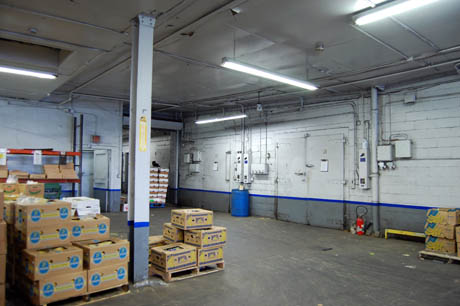
IMAGE: Behind the heavy doors that open off this main space, thousands of bananas are being ushered through each stage of the ripening process.
During our visit, Paul Rosenblatt told us that he aims to ripen fruit in five days at 62 degrees, but, to schedule fruit readiness in accordance with supply and demand, he can push a room in four days at 64 degrees, or extend the process to seven days at 58 degrees.
“The energy coming off a box of ripening bananas could heat a small apartment,” Rosenblatt explains, which means that heavy-duty refrigeration is required to keep each room temperature-controlled to within a half a degree. In the past, Banana Distributors of New York has even experimented with heating parts of the building on captured heat from the ripening process.
To add to the complexity, customers can choose from different degrees of ripeness, ranging from 1 (all green) to 7 (all yellow with brown sugar spots). Banana Distributors of New York proudly promise that they have “Every Color, Every Day,” although Rosenblatt gets nervous if he has more than 2000 boxes of any particular shade.
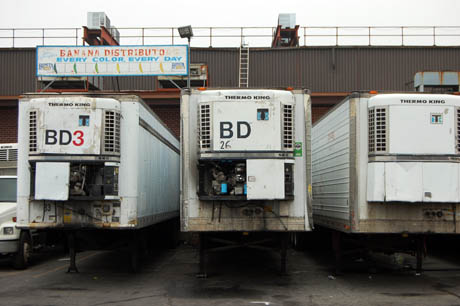
IMAGE: Refrigerated trailers stand ready to be loaded with “Every Color, Every Day.”
To provide this variety every single day, a banana ripening facility has to have a minimum of five or six rooms (Banana Distributors of New York has twenty-two). Each room holds between 1,000 and 2,000 boxes, which means that a banana distributor has to move at least 5,000 boxes each week to make the business worthwhile. This, Rosenblatt explains, has squeezed out the two dozen smaller, three- or four-room operators that used to be sprinkled around New York City in the 1970s.
The most popular shades are between 2.5 and 3.5, but much depends on the retailer’s size and target market. The grocery chain Fairway, which sources its bananas from Banana Distributors of New York, expects to hold bananas for a couple of days, and will therefore buy greener bananas than a smaller bodega that turns its stock over on a daily basis. “Street vendors,” Rosenblatt notes, as well as shops serving a mostly Latin American customer base, “like full yellow.” Personally, he eats only a couple of bananas each week, and favours fully ripe “sevens.”
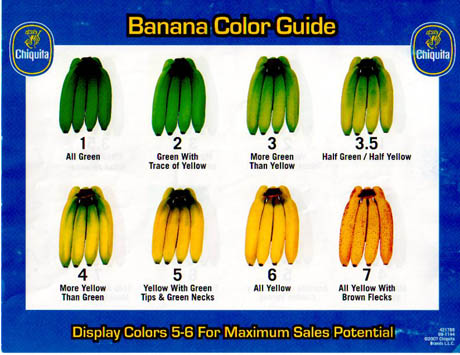
IMAGE: The Chiquita banana colour guide.
In addition to precise temperature control, the ripening process also depends on atmospheric design. Over a 24-hour period, each roomful of bananas is gassed with ethylene, a plant hormone that accelerates ripening (and is also, curiously, the most produced organic compound in the world).
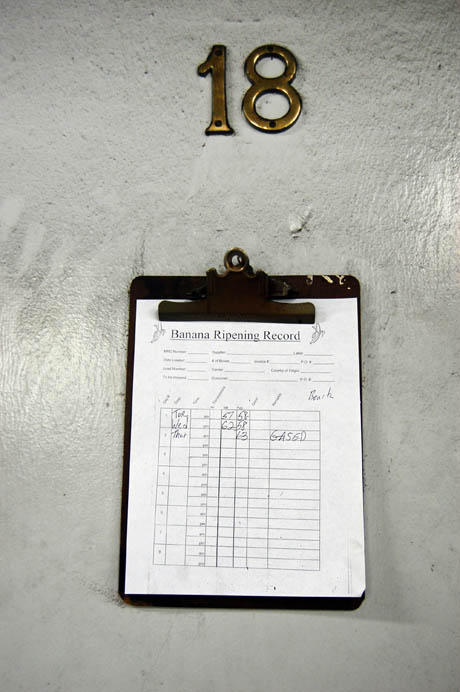
IMAGE: A clipboard hung on or near the door of each banana ripening room keeps track of the ambient temperature and ethylene gas injection.
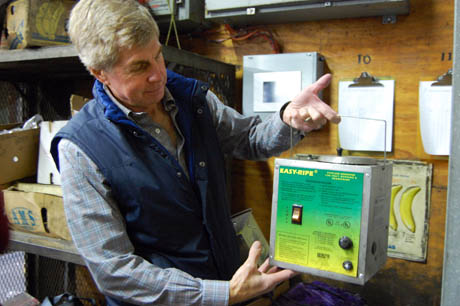
IMAGE: Paul Rosenblatt holding an ethylene generator in front of a banana colour guide.”
The ethylene is produced in a low, even flow from portable “Easy-Ripe” generators. In the past, Rosenblatt, explained, rooms would be injected with a burst of ethylene released from a cylinder, which not only made it much harder to achieve an even distribution among the stacked bananas, but also posed a heightened fire risk (ethylene is highly flammable, and in the early days of injection technology, fatal banana ripening room explosions were not uncommon).
When Rosenblatt opened the door on a recently gassed room, the smell was revolting — like a wine-soaked carpet, the morning after.
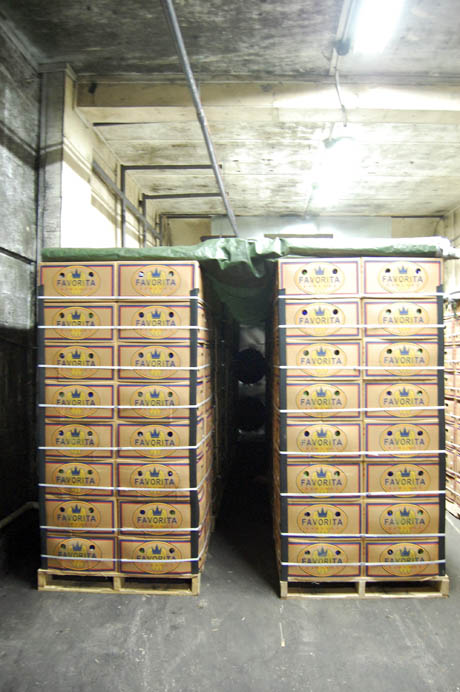
IMAGE: Bananas stacked in the original 1970s pressurised rooms.
For students of the artificial cryosphere, a visit to the Banana Distributors of New York is particularly exciting because original pressurised rooms from the late 1970s are still in use, alongside state-of-the-art Dutch door technology. The older rooms are a legacy of the pre-pallet era, when bananas used to arrive loose and were carefully stacked from concrete floor to ceiling “like bricks,” packed tight and fan ventilated to force air around each hand.
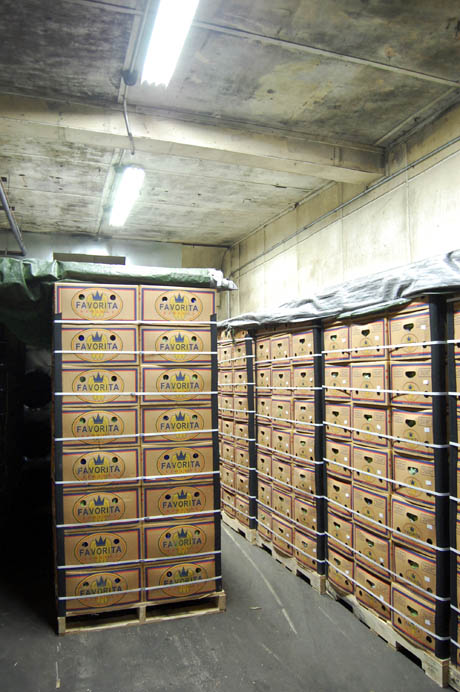
IMAGE: Bananas stacked in the original 1970s pressurised rooms.
Using these old rooms to ripen today’s boxed bananas requires a few adaptations: eight-box stacks are covered with a tarp to create a vacuum, and three axial fans draw air through the carefully measured corridors in between. Even and efficient air circulation is critical to successful temperature control and ethylene distribution, as is occasional venting, as the ripening bananas consume oxygen and release carbon dioxide.
“With bananas,” explains Rosenblatt, “it’s all about ventilation.”
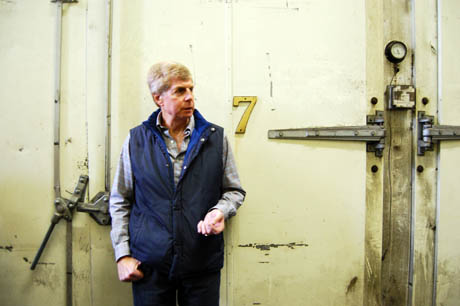
IMAGE: Paul Rosenblatt in front of the world’s first two-tier banana ripening rooms.
The next rooms that Rosenblatt showed us are, he mentions almost as an aside, the first two-tier banana ripening rooms ever built. In 1988, he explains, “this guy called Jim Still came along and offered to build them for free, as an experiment.” They worked, and Jim Still is now known as Banana Jim™, founder and president of ripening industry leaders, Global Logic, LLC.
In addition to increased capacity and improved ripening uniformity, these vertical air-flow banana chambers can be loaded and unloaded using fork-lift trucks in twenty minutes or less.
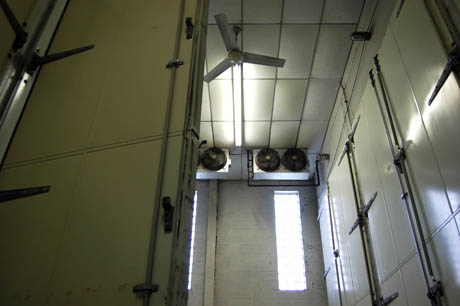
IMAGE: The world’s first two-tier banana ripening rooms.
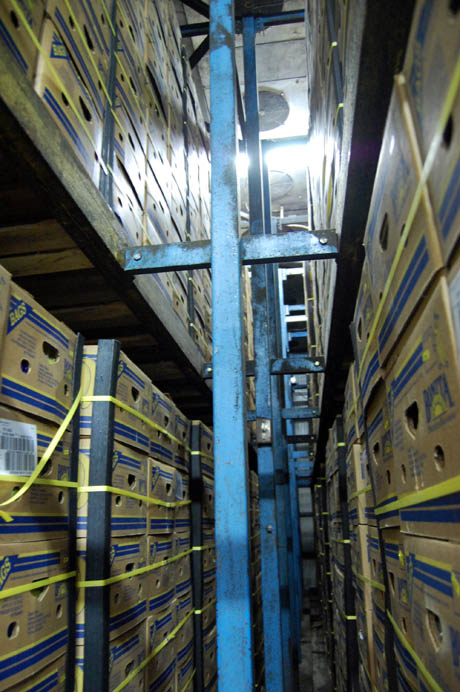
IMAGE: In these two-tier ripening rooms, the fans hang on the ceiling, so that air is forced rather than drawn through, allowing for even more uniform ripening.
With minor improvements in fan engineering, and the optional addition of a third tier, brand-new banana ripening rooms still look identical to today. “All the technological innovation,” Rosenblatt tells us, “is to be found in doors.” He points out some old roll-up air-tight doors, explaining that “we call these widowmakers — we never stand under them.”
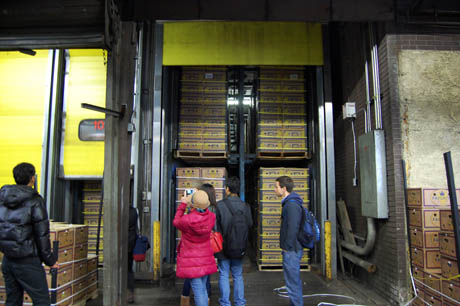
IMAGE: Students dice with death (sorry kids!) under the widowmaker doors.
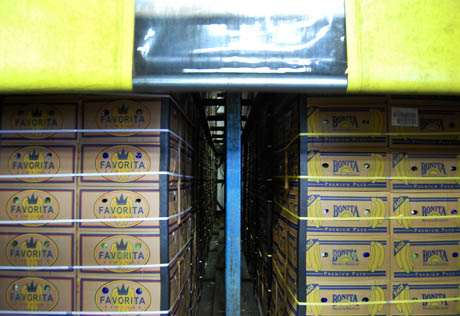
IMAGE: New, safer rolling air-tight ripening room door technology in action.
I asked Rosenblatt about new, in-container ripening systems, which threaten to make the banana ripening room extinct by integrating the process into the final few days of a banana’s boat journey, so that it can be unloaded from a freighter and trucked straight to the supermarket. “Banana Jim” Still has actually filed a patent for his Ripe-Anywhere™ container system, and promotes it under the humble tagline, “It was a modest invention… but it changed a planet.”
Rosenblatt is not convinced: “Walmart could do containers, but in New York City, retailers don’t have the volume.” Nonetheless, the future of his family business is uncertain. While his father-in-law got his start in the fruit trade at the age of eight, working for street pedlars, Rosenblatt told us that he hopes his own children don’t go into banana ripening.
The hours are certainly unappealing: Banana Distributors is open from 10pm to noon every night. To the downsides, I added my own mistrust of banana boxes, dating back to a scarring experience with a large, furry spider as a sixteen-year-old shelf stacker at Waitrose. However, Rosenblatt told us that in his 39 years in the banana trade, he has never seen a snake, and has only come across one spider, which he gave to the Bronx Zoo.
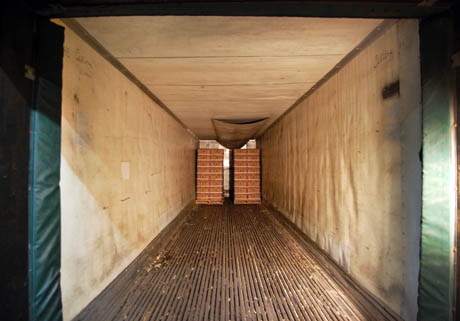
IMAGE: A trailer holds twenty pallets of bananas, or half the capacity of a two-tier ripening room.
We said goodbye as the final trailer was being loaded and shipped out for the day. Nearly two million bananas pass through these ripening rooms on their journey to New York consumers each week — a vital link in the largely invisible, highly specialized architecture of artificial refrigeration that has enabled the banana to become and remain America’s favourite fruit.
[NOTE: Thanks to Darien Williams for introducing me to the Chiquita commercial!]

I love bananas!! Would love to work here.
I’ve googled and can’t find anything about bananas on planes. Well, twice now I have innocently taken bananas, definitely ‘all yellow’ and firm, on commercial flights – one transpacific 12 hour flight, and one 2-hour domestic. Each time I was horrified/amused to find the banana quite inedible, almost all black and very ‘mushy’, after I’d landed.
I guess they don’t like the cabin pressurisation !? LOL)
Great article.
It’s very intersesting to see how things have changed over the years. My Dad drove a tractor trailer for BD from around ’73-’76, when Paul had red hair and drove a Mach I Mustang. At that time, they were located at the opposite end of Halleck St, near the end of Hunts Point Ave. The bananas were unloaded from the ships and onto the floor of the trailer by hand, then unloaded from the truck by hand and put into the various rooms at BD. No pallets or containers back then.
Any time I ate a banana it was out of one of the rooms and to this day will only eat a banana cold. According to the chart, I’m a 5 or 6 kinda guy.
I worked there with Paul for my Uncle John in the late 70’s early 80’s mostly as a delivery driver all the boroughs except Statin Island. We delivered directly to supermarkets and all the little fruit markets.We moved a lot of bananas things sure have changed since. Except people still love bananas.
Great essay, thanks. Oddly, anything under 7 upsets my stomach. But I eat a 7 every day. And here I was hoping to be a 10. 😉
Back in the dark ages when I was a kid growing up in NJ, our next door neighbor was an executive with United Fruit. He would often show up with bunches of #7’s and distribute them to the neighborhood. My Mom was a 3.5 person, so we ate a lot of banana bread.
Thanks for the memories!
I’m going to use this information in my logistics class. What an outstanding article.
Nice article. I eat two bananas a day, preferably with dark spots on the yellow peel. I have determined that if I do not, I get cramps in my legs, usually at night. I have to limit sodium intake and the potassium in the bananas keeps the balance in my body. A good thing I love bananas. Of course where I come from we let the bananas ripen in the bunch hanging from the roof. No need for refrigeration neither for ethylene, which by the way is also naturally produced by the bananas as they ripen and trigger the ripening of adjacent fingers.
Just thinking about the energy required to get a properly “ripe” banana at the local grocery store is astounding.
Fascinating piece. You can probably tell from the name and content of my blog that a 7 is my actual worst nightmare. I’m a 3.5 all the way.
Terrific essay, well-researched and well-presented.
Bananas are the worlds favorite food. Would love to work there, I’d be eating bananas constantly. Bananas with the brown flecks are definitely the best banana state to eat.
George Sr you are a dog, sir. But I like you.
Thank you for this post. Very enlightening.
There’s always money in the banana stand…
Wow, totally gripping and immersive essay.
I like to buy 4s and eat them at 5. 6s are too sweet and 7s, cloying. No 8s but those are perfect for baking.
What Josh said. Also, I prefer to eat a four – just a little sweet.
fascinating, as usual. sounds like a great class!